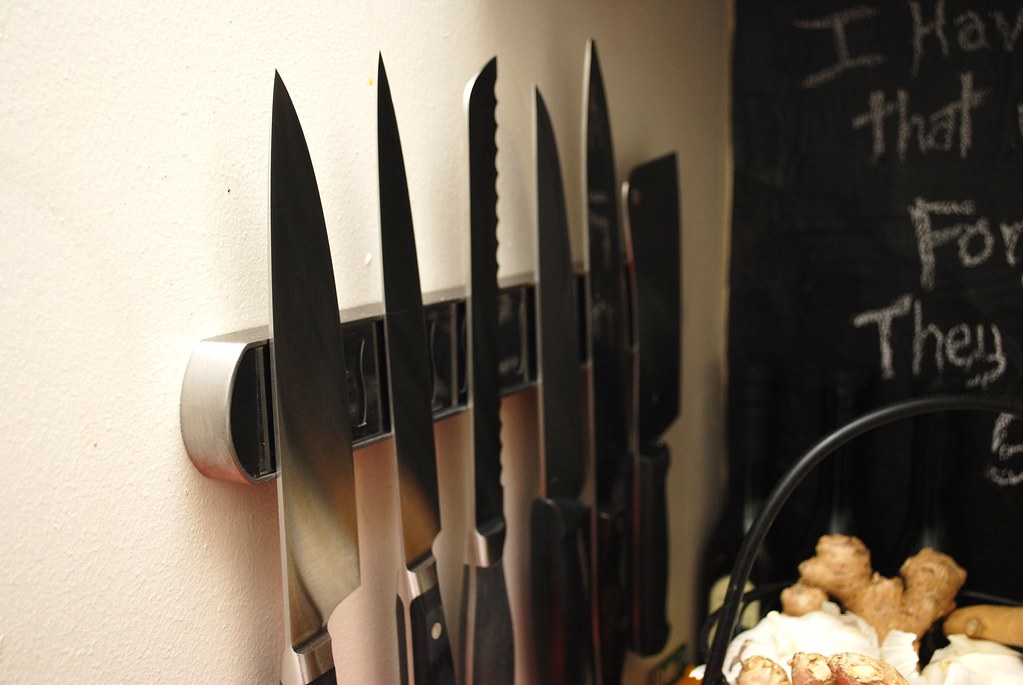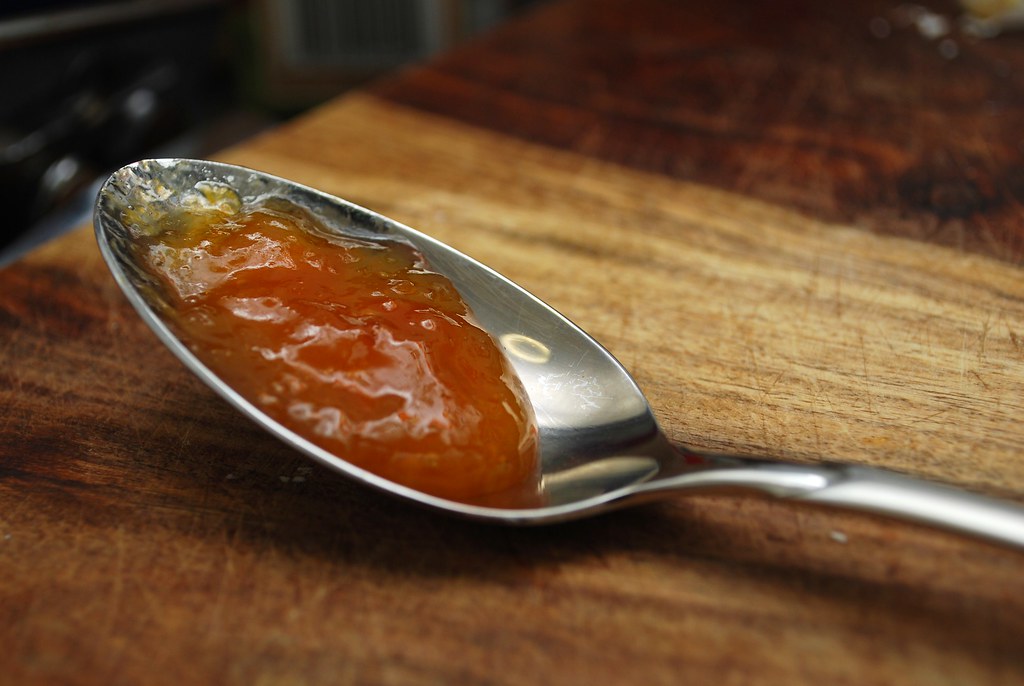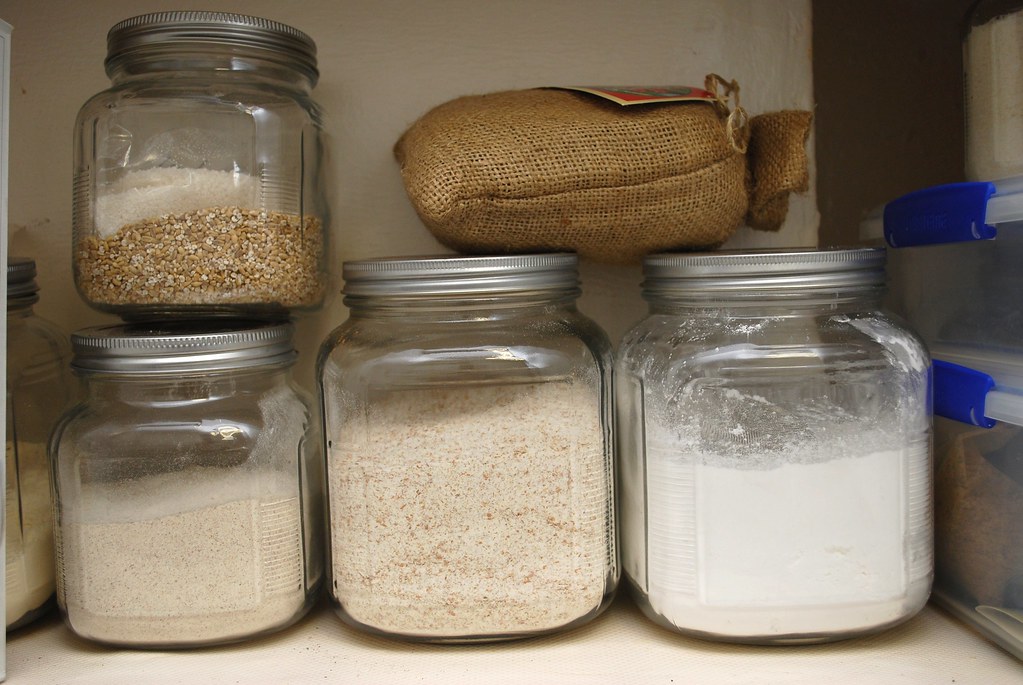 Despite my best intentions, I've realized that each week, I throw out at least a couple bags or containers of spoiled food. I don't know about you, but I get an awful feeling watching the once lush bag of cilantro sitting in a murky and slimy green puddle on top of the trash.
Despite my best intentions, I've realized that each week, I throw out at least a couple bags or containers of spoiled food. I don't know about you, but I get an awful feeling watching the once lush bag of cilantro sitting in a murky and slimy green puddle on top of the trash.I know I'm not alone; a recent study found that Americans throw away 50% more food today than they did back in 1974. How awful is that? Not only is 50% more food going to waste, a lot of money is also being tossed away along with the slimy parsley and shriveled carrots.
In my apartment, I've estimated that I probably throw out about 10 to 15 dollars worth of unwanted food a week (think freezer-burned leftovers, poorly stored grains, spoiled produce, etc.). In a year, that's enough money for a decadent multi-course dinner at a top NY restaurant or a round-trip ticket to the Caribbean!
In an effort to reduce food waste in my own kitchen, I've started incorporating the following tips into my regular routine and will try to make a habit of each of them by year's end. Even just by following one or two of these, I've found that I'm throwing out a heck of a lot less. If you're looking for ways to curb food waste in your own home, perhaps some of these tips will help:
 1. Become a Grocery Day Prep Cook
1. Become a Grocery Day Prep CookIn professional kitchens, a prep cook is the person responsible for most of the washing, peeling, cutting, and chopping of vegetables and other ingredients. They're also the ones responsible for storing items, covering items properly, and preparing some items ahead of time so they can be quickly used during cooking. Few of us can afford to have our own personal prep cook hanging around the kitchen, but the truth is, it really only takes about 30 extra minutes on grocery day to be your own best helper.
- Wash, peel, and pre-cut cumbersome fruits like melons and pineapple, and vegetables like broccoli and celery, before putting them away in air-tight bags or containers. I promise you that having them all ready to go will make you more likely to use and eat them in the middle of a busy morning or during the after-work dinner rush.
- Dice up a couple onions (just a couple...not the whole bag!) and keep them in an air-tight container in the fridge; you'll just have to scoop them out by the spoonful for quick omelets and sautés throughout the week.
- I’m guilty of buying those overpriced "salad in a bag" things because they are SO convenient and more likely to get used that a whole head of Romaine. But guess what? By washing and tearing salad greens, then storing in large gallon-sized Ziploc bags, you’ve got your own “salad in a bag” at less than half the price. Weekday salads will be as easy as grabbing a handful and tossing with your favorite dressing! Try this trick and I guarantee you’ll be eating more greens while wasting less.
- Buying tubs of yogurt and cottage cheese, or large jars of applesauce can save you money...but not if they're left to spoil in the back of the fridge. Portion out individual servings of your favorites into 1-cup single-serving containers (I like these reusable ones by Ziploc) and place them front-and-center in the fridge for easy grabbing on your way out the door.
2. Buy Time with the Freezer
Food that lasts only a couple days in the fridge can last months (sometimes even a year!) in the freezer. It might seem incredibly obvious, but I know I’m guilty of letting things expire in the fridge when I could have easily frozen them.
- Maybe you were planning on making chicken cutlets this week but your boyfriend came home with good news and decided to take you out to celebrate. And the next day things got crazy at the office and you ended up just ordering in? Don't just leave the chicken in the fridge to spoil! Wrap it well in a double layer of plastic wrap and foil, and toss in the freezer until you have the time to use it.
- The same goes for leftovers. You already ate lasagna twice this week and are bored to death looking at the half-tray still left in the fridge. Don’t throw it away! You might be sick of it now, but it’ll make a perfect easy lunch sometime later this month. Portion it and place in the freezer. (See tip #6 below for a way to keep from forgetting it’s there.)
 3. Think like a Retro Housewife
3. Think like a Retro HousewifeMid-century housewives had tight budgets and were no strangers to creativity in the kitchen. Look up some classic recipes online or in vintage cookbooks, and put those leftovers to work.
Leftover Chinese takeout rice or this morning’s oatmeal is great for thickening up a stew. Leftover pasta can be cooked with eggs into a yummy dinnertime frittata. Egg roll wrappers can be stuffed with just about everything (leftover chicken, ground meat, stir-fried vegetables) for a quick and fun meal. Soups can be reduced and become a sauce for pork chops or a filling for quesadillas or wraps. And remember to save all your carrot and celery tops in a freezer bag for a delicious soup base!
Bonus: Been meaning to call your mom or grandmother more often? This is a great excuse to give her a call and ask for a few tips. You might even score a few priceless family recipes!
4. Beyond Banana Bread
Everyone knows overripe bananas can find new life in banana bread, but did you know that you can add extra flavor and fiber to quick breads and muffins with slightly-too ripe peaches, pears, or even mealy apples? Fruit and veggies that are slightly past their prime, can still find new life in sauces, soups, and baked goods. A few less-than-perfect apples would work nicely in this Cinnamon Apple Butter recipe and or this Apple Cake. My Banana Bread Recipe actually calls for an overripe peach.
Stale bread and crackers can be ground into crumbs for breading for these Smoky Jalapeno Poppers or Fried Macaroni & Cheese Patties. You can also toss slightly mushy tomatoes or dry garlic cloves in a pasta sauce like my Arrabiata. (Just make sure to check them carefully for any signs of mold or rot before you add them in.)
 5. Good to the last Drop
5. Good to the last DropThat final tablespoon of apricot jam at the bottom of the jar can be used as a substitute for honey in your tea. The last few spoonfuls of cottage cheese or cream can be added to your salad dressing to make it creamy. Even a single slice of bread can be diced and toasted into croutons.
Always think twice before tossing out the tiny bit that's left; it sometimes only takes a little bit of something to spice up an old recipe!
6. Do the Weekly Cupboard Shuffle
Growing up we had a rule that we couldn't tear into the new cereal boxes until the old ones had been completely eaten. It was annoying as anything since all my brother and I wanted to do was eat all the marshmallows in the Lucky Charms, but the truth is that it kept us from throwing out half-full boxes of stale cereal.
When putting away items in your pantry, pull out all the opened boxes first and line the new packages all the way in the back. Studies show that we eat what we see, so we'll be more likely to finish up those older boxes before they expire as long as they're stored up front.
 7. Redecorate the Pantry
7. Redecorate the PantryFood usually comes packaged in boxes and containers that really aren't the best for storage. Flimsy paper flour and sugar bags let in moisture and can easily tear. Cereal and pasta boxes pop open and make everything go stale. And plastic bags of rice and lentils have a tendency to flop over and spill whenever you're at your busiest.
Check out organizational retailers like the Container Store, Bed, Bath & Beyond, or even Amazon, for attractive and durable storage alternatives for your pantry staples. Last year, my boyfriend and I bought three huge bags full of glass storage jars in various sizes and I now use these to store all my baking supplies (flours, sugar, grains, pasta, etc). Not only do they look nicer, but they keep my most-used ingredients easily accessible and fresh longer. (No more hard chunks of sugar.)
I also like to run old jam, spaghetti sauce, and juice jars under hot water or through the dishwasher to thoroughly clean and remove the labels. These can then be reused for storing homemade sauces or preserves, small quantities of liquid leftovers (like fish stock or chicken soup, for example), or to organize beans and grains. I love opening up my pantry door to see the nicely lined collection of jarred dry goods; makes me feel like I’m running an old fashioned general store!
 8. Keep a Reverse Grocery List
8. Keep a Reverse Grocery ListInstead of making a list of the items you've run out of or need to buy, try keeping a list of the items you have stocked in the fridge along with any expiration dates (as noted on the milk or meat packages). Tape it to the fridge door at eye level and mark off items as you use them (it helps to also attach a pen nearby).
Not only will you be creating an instant grocery list, but you’ll never again find yourself dumping out a half-gallon of spoiled milk you forgot to drink or tossing a bag of mushy tomatoes because you forgot you ever bought them. You can also create a list for the freezer to help keep track of the frozen leftovers and meat you toss in there—no more “freezer burned mystery packages” behind the ice cream!
9. ...Or try a “Guilt List”
Keep a blank pad or dry erase board on the fridge, and every time you find yourself throwing away an unused bag of mushy peppers or a carton of spoiled milk, write it down. At the end of the month, take a look at just how much you wasted and use it to make decisions about your future buying habits.
Are you always throwing away most of a gallon of milk? Maybe you should start buying it by the quart. Did you throw out two complete containers of mushrooms last month? Seems like you’re not really mushroom eaters...so stop buying them!
 10. Occasionally, Remember to Shop the Pantry
10. Occasionally, Remember to Shop the PantryEvery so often, I climb on top of my counter to check the top shelves of my cupboards. That out of reach shelf is usually where I toss cans and boxes that don’t fit anywhere else, but because they’re so out of reach I usually forget what’s up there.
- Every now and then (usually BEFORE a grocery trip), take a good look at your pantry and try to figure out ways to make meals using up the food you already have: cans of tuna or sardines, boxes of pasta, soup packets, bouillon cubes, lentils. Pull a few things out and make an inventive meal with what you find.
- If you can’t think of any ideas, search for specific ingredients on a site like Tastespotting to see what others have made with it, or get yourself a copy of Donna Hay’s book “Off the Shelf.” This gorgeous book has tons of recipes for entrees, appetizers, and even desserts made primarily from pantry staples.
New to Always Order Dessert? Consider subscribing to my RSS feed, follow me on Twitter, or sign up to receive my once-a-week e-mail updates by filling in your address in the box on the right. And if you ever need any entertaining or cooking advice, please don't hesitate to e-mail me.


